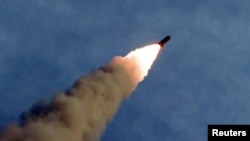Christy Lee contributed to this report.
The threat of North Korea launching a nuclear-capable missile from a submarine is real but not imminent, experts said, after recent satellite images displayed a docked craft with missile capability.
“If you really want to be able to launch a ballistic missile that could hold a nuclear weapon, you have to have a very high degree of reliability. And that can just take time,” said David Albright, a former U.N. nuclear inspector who now is a nuclear proliferation analyst at the Institute for Science and International Security. “And the only evidence we have seen so far is the outer part of the submarine. And so, it’s a big jump from that to the imminent threat.”
Satellite photos of North Korea’s Sinpo South Shipyard taken on Monday show vessels and a crane that could be used to move a missile barge for a ballistic missile test from a submarine, according to a report by the Center for Strategic and International Studies (CSIS).
The report, written by analysts Joseph Bermudez and Victor Cha of CSIS’s Beyond Parallel project, confirms a July 23 report by North Korea’s Korean Central News Agency’s (KCNA) showing North Korean leader Kim Jong Un inspecting a new submarine.
The CSIS report said Kim’s inspection in July seems to have taken place at the Sinpo South Shipyard, site of the Korean People’s Navy’s submarine missile tests.
KCNA reported in July the “operational deployment” of the new submarine “is near at hand.” But the CSIS report called the threat from the submarine “emerging rather than imminent.”
The submarine will have to go through a period of trials and tests that could take more than a year, the CSIS report said, before becoming fully operational. “There is no conclusive evidence at the moment that this is a near-term certainty,” said the report.
James Holmes, a maritime expert at the U.S. Naval War College, said North Korea “has a strong incentive to hype its progress” because it “does burnish Pyongyang’s standing with the North Korean populace” while also creating “a kind of virtual deterrence.”
“If a [North Korean] ballistic missile submarine appears poised to put to sea — whether the appearance is true or not — that will begin to influence diplomatic and military calculations in regional capitals right away,” said Holmes.
The CSIS report, however, highlighted the fact North Korea’s submarine appears to be capable of launching nuclear-tipped ballistic missiles.
“The construction and commissioning of a true [ballistic missile submarine] would present a significant escalation of the North Korean ballistic missile threat and complicate defense planning in the region,” the report said.
It also noted the satellite images suggest “North Korea is making real progress in developing a second leg of the nuclear triad, bringing them closer to a survivable nuclear force and lessening prospects for full denuclearization.”
The nuclear triad refers to three ways of launching nuclear weapons. Warheads can be carried by land-based intercontinental missiles, submarine-launched ballistic missiles and strategic aerial bombers.
North Korea has conducted nine missile tests since May in apparent efforts to improve land-based missile launching technology, steps opposite from denuclearization, contradicting its promise made last year.
Diplomacy between Pyongyang and Washington has been stalled since the breakdown of the Hanoi Summit held in February, when Kim failed to secure sanctions relief from U.S. President Donald Trump in exchange for partial denuclearization.
North Korea’s launches this year suggest that it has developed advanced missile technology that can evade pre-emptive strikes targeted to destroy missiles before launches and missile defense systems aimed at intercepting incoming missiles in flight.
Bruce Bennett, a senior defense analyst at the RAND Corporation, said the submarine that North Korea unveiled in July is not newly constructed but a modified version of an old Romeo-class submarine with added ballistic missile launch capabilities.
Romeo-class submarines
North Korea imported the Romeo-class submarines from China between 1972 and 1975 and built several more using Chinese-supplied parts between 1976 and 1995, said Bennett.
The Romeo-class submarines were introduced in the late 1950s by the former Soviet Union, which shared the submarine’s design with China. In the 1970s, China transferred seven Romeo-class submarines to North Korea. North Korea is thought to have about 20 Romeo-class subs.
Bennett said, “It is my perception that both the North and South Koreans have been overplaying the North Korean ballistic missile submarine threat, especially since the submarine that has been demonstrated thus far is actually a remake of a North Korean attack submarine, probably produced 25 or more years ago, based on a Russia design from over 60 years ago.”
He continued, “Nevertheless, even this North Korean ballistic missile submarine will likely force the U.S. and [South Korean] navies to station [military] assets off North Korean ports to track the submarine if/when it goes to sea.”
The submarine is believed to be capable of carrying three KN-11 ballistic missiles that have the range to threaten U.S. forces in the region.
The submarine has some drawbacks, including being noisy, which makes it less stealthy and therefore susceptible to an attack.
Bennett said, “Would the United States tell North Korea that it is not allowed to test a missile from this submarine, and that if it tries to do so, the submarine will be sunk?” He continued, “It is not clear to me that a U.S. president or a [South Korean] president would be prepared to make such a threat, making the regional countries vulnerable to a surprise attack from this submarine.”
Trump has been downplaying North Korea’s recent missile launches, while South Korea pulled out of an intelligence-sharing pact with Japan last week against U.S. urgings to renew the agreement that shares sensitive military information with Japan.










